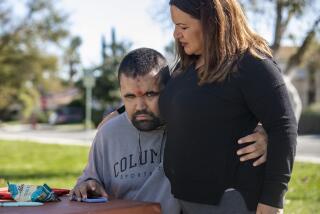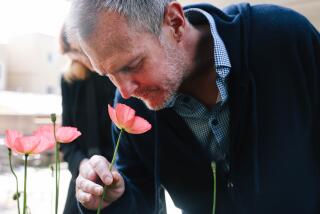At Home, at Last
- Share via
Ann Belles and her husband, Jim Silcock, anxiously study the stream of passengers departing customs and walking up the ramp at LAX’s Terminal 2. An hour has passed, and there still is no sign of their 16th son, due in from Romania.
Like the others, this son will arrive a stranger. They know little about him, except that he is 6 or 7, speaks no English and has lived in an orphanage most of his life. They’re not even sure how to pronounce his name, Alin.
He is different from all but one of their other children in that he has no known physical, cognitive or medical disability. It was Belles who first spotted his photograph on the Internet about a year ago. She was drawn into his eyes, which conveyed a potent mixture of desperation and hope. Almost always, when she sees that look, she ends up making room for another child at the family’s long, wooden dining table.
Their children, all boys, range in age from 2 to 22. Racially, they pretty much cover the spectrum. Their disabilities include spina bifida, muscular dystrophy, cerebral palsy and fetal alcohol syndrome.
They come to Belles and Silcock in search of a place in the world. Many have backgrounds of abuse and neglect. Because of the severity of their disabilities, they have been handed off from one person to the next throughout their lives, arriving more like pocket change than children.
Seven of them are adopted. Belles, 37, and Silcock, 38, serve as guardians, conservators or foster parents to the others, most of whom are at various stages in the adoption process. There is no special reason for all boys--except that they seemed to be the ones most in need of a home. And, now, with so many kids, the logistics are simpler.
“When people ask me how many kids I have, it’s confusing in a sense,” Belles says. “Usually, I just say, ‘A lot.’ ”
It is the family she has always wanted, built with children no one else would have. She says she has always known that being a parent was more about giving life than giving birth. By the time she was 19, she was a foster parent, taking in children almost as old as she was. In 1998, after laws were changed to expedite the adoption process for foster children, she began adopting the children who had been placed with her.
That same year, she met Silcock, who was living in Florida. She was new to computers and was fumbling her way around cyberspace when Silcock’s profile popped up on her screen. She was a bit surprised. Then she read that he was quadriplegic, the result of a 1987 diving incident, and that he did volunteer work and was a board member for a disabled veterans’ group. She sent him an e-mail, uncertain of what one should say under such circumstances. “How’s the weather down there?” she asked.
The weather, it turned out, was pretty good. Before long, Silcock was on an airplane bound for Southern California. Four months after they met, they were married.
The family’s Huntington Beach home, located on a quiet, orderly cul-de-sac, has seven bedrooms, four bathrooms, 3,000 square feet, nine trash cans and two dogs. The long front hallway leading to the kitchen is lined on both sides by framed artwork created by the children. Their photographs hang along the a hallway that connects their bedrooms. The garage is a boneyard for 20 years’ worth of old wheelchairs, braces, shower chairs and ramps. Out front are the family’s four vans, three of which accommodate wheelchairs.
Four of the older boys live in their own apartments with roommates to assist them. To help with those still at home, Belles and Silcock have a staff of 16 who help care and transport all the kids each day and keep house.
While dinner often is served in shifts, the family is usually together for breakfast. As they gather around the table, it sounds more like a restaurant than a family dining room. Several conversations take place at once, and voices are raised to be heard. Those who can, take their plates and cups to the sink when finished.
When all the children are home, it is filled with voices and the clatter of walkers and crutches, whir of wheelchairs, the noise of TVs, music, video games and a washer and dryer that seem to never rest. It has given rise to one of life’s lessons taught to Silcock: If given the opportunity, he says, always take the extended warranty.
At night, Belles and Silcock split up to make the rounds to each bedroom and say good night, read a story to Jarrod, blow bubbles for Grant. Belles listens to monitors placed in three or four rooms and every night awakens to change a diaper, shift someone’s position in bed, clear a tracheotomy tube, chase nightmares away.
For all that is going on here, room has been made for one more.
Which is what has brought Belles and Silcock to LAX, where they wait and watch. Alin was originally to have arrived Dec. 6, but problems with his visa delayed things until Dec. 14. When they first see Alin, he is walking up the ramp next to a man pushing a luggage cart. Belles waves, and the boy smiles, then looks down at the floor as he and the man approach.
The cart contains two suitcases and a plastic bag. The suitcases belong to the man, vice president of the adoption agency who has escorted Alin to America. The plastic grocery bag is Alin’s. It contains notebooks from school, a few photographs and nothing more.
Belles places a hand on the boy’s shoulder. Her movements seem uncertain, almost awkward. At Silcock’s suggestion, she hands the boy a bag filled with toys and school supplies. As they walk away from the man, she holds her hand out. Alin reaches up for it. Again, he smiles. In the van, as traffic hiccups down the crowded 405, and darkness descends, Alin falls asleep next to Belles. He has found a new place in the world.
*
The day of Alin’s arrival is also the day of the annual Christmas party at St. Bonaventure Church in Huntington Beach, an event put on by the youth ministry for local children with disabilities. Belles and Silcock had originally thought there would be time to take Alin home to settle in before loading up the troops for the party. Because of his late arrival, however, Belles is on the cell phone from the van letting the staff at home know that they will have to meet at the party. She asks if someone can bring a change of clothes for Alin so he has something fresh to wear.
As they arrive at the church, Alin seems re-energized by his nap. He is intrigued by balloons that drift to the ceiling of the huge room. He sits next to one of his new brothers, Hunter, 13, and loads up on macaroni and cheese, a piece of chicken, pizza. Hunter has a sense of what it’s like to be a new arrival in this family. His initial thought a year and a half ago when he first saw his brothers was, “Oh, my God.” It was a bit overwhelming, he says, even scary. Now that he has adjusted, however, he describes the family as “big, loud and, on occasion, smelly.”
Hunter’s name was Joe when he arrived from South Carolina. Soon after he enrolled in school, however, Belles and Silcock started getting calls for Hunter, not knowing who Hunter was. It turned out Joe decided on his own to change his name to Hunter in an attempt to sever painful ties to the past. Like the others, he has progressed beyond many people’s expectations since living with his new family. He learned to use a walker after he got mad one day and ruined his electric wheelchair by sending it into a pool of water.
Belles recalls the conversation that followed--an important one, it turned out.
“Gee, that’s too bad,” she told Hunter. “I wonder how you’re going to get to school.”
“I’ll get another one,” he told her.
“They’re very expensive. I don’t think we can afford one,” Belles said.
“You can drive me to school.”
“I guess we could, but we’re awful busy.”
“I’ll take a taxi.”
“Maybe you should call and see how much it costs.”
Finally, there was only one solution. Hunter, who until then was able only to stand for 40 seconds, pulled himself up with a walker and took his first steps. From that point on, he has been walking to school. Initially, it took him 45 minutes to an hour to cover the three blocks. Now he makes it in about 20 minutes.
“Children seem to blossom around Ann and Jim,” says Nancy Andrews, a registered nurse who has worked with Belles for nearly 10 years. “The focus in that home is to strive for the best outcome, whatever that might be, with each child.”
Seven years ago, Belles found Robert in a Southern California institution. “They had him in a crib with a lid on it,” Belles says. “It looked like a cage.” At age 12, he could not walk or feed himself. Now, at 19, he walks and even works as an actor. “He has a Screen Actors Guild card, so he went from a kid that nobody had any expectations of with severe disabilities to someone who will have a fulfilling life and contribute to society,” Belles says.
Family members are expected to carry their own weight. Those who can, must feed and dress themselves. The children participate in daily after-school activities ranging from gymnastics to karate to field trips. “My belief,” says Belles, “is that everybody belongs in the community and everybody needs to be a productive member of society.”
Patrick McLogan, executive director of International Christian Adoptions in Temecula, has known Belles for nearly 20 years. The agency has placed four children with the family in the last three years.
He visits the home regularly and says the family is unique not only in terms of size but also in how its members relate to one another. “This is not institutional care,” he says. “This is a family.”
*
The role of parent is relatively new to Silcock, who, before meeting Belles, had no experience with children. While Belles’ life has been one of staying the course, Silcock’s has taken many turns. There was the day in 1971 when his mother was killed by a drunk driver, the day in 1982 when he was almost killed in a car crash, the day in 1987 when he dived into shallow water and broke his neck. But also the day in 1992 he quit drinking, the day in 1996 he graduated from the University of Miami with a business degree, the day he met Belles, and each day like today, when he welcomes a new son into his life.
Belles cared for many of the boys before Silcock entered their lives. His effect on them, she says, is immeasurable.
“These kids are seeing their dad, who has significant disabilities--in fact he is more disabled than the majority of the kids. He teaches, he acts, he owns his own business. He’s married, he parents, he drives. He goes about his life with his disability. That’s been pretty neat for these guys.”
The role of parent has been a nice fit, says Silcock, who often wheels about the house with at least one son on his lap. The rewards are constant.
“When the kids say, ‘That’s my dad,’ it makes me melt,” he says. “Seeing them walk for the first time . . . . Like Javier, he was in a wheelchair and had never used a walker when we got him two years ago. Now he can walk without crutches.”
He shares with them an interest in acting. All but two of the children have worked as extras this year. Silcock’s most recent television appearance was on the season premiere of “The Drew Carey Show.” He studies acting through classes offered at the Media Access Office in North Hollywood, an agency that assists actors with disabilities. “It gives me focus,” Silcock says. “It allows me to be creative. It’s something I can do without any assistance from anybody.”
Although acting brings in some money, the family’s main source of income is its business, First Step, which helps adults with disabilities get the help they need to be able to live in their own homes.
To help offset expenses, the family also receives monthly assistance from the state, ranging from nothing to almost $5,000 per child. It helps pay for expenses related to the children’s disabilities but does not cover the family’s day-to-day living expenses.
With the arrival of each new child, the question surfaces: How many more children can they take? There is no clear answer.
“We get calls all the time,” Belles says. “In a way, we’re sort of the last resort, so it’s very difficult for me to say no. I think that if everybody could adopt one or two kids, it would take the pressure off me.”
She says this only half-jokingly.
*
At the Christmas party, the children are scattered throughout the room at St. Bonaventure. Alin, for the most part, stays close to Belles. Christmas music plays, and it has been rumored that Santa is on his way.
Alin’s new brothers are in a festive mood, but one of them, Grant, has no expression on his face. The boy with slow, gray eyes is being pushed around in a wheelchair. He is 5 years old, and when he was born with a fatal illness, doctors said 5 years might be all he had. He has not seemed well of late, and Belles and Silcock aren’t sure whether it’s a temporary setback or a sign of final decline.
“He goes to kindergarten. He’s at least happy,” Belles says. “He’s never going to read or write or walk. I know that, but we’re giving him every opportunity to experience the world and gain the skills that may be helpful to him if he is able to live.”
Grant is one of the children Silcock and Belles are in the process of adopting.
The oldest son still at home is Jose, who will set out later this month and move into his own apartment. The 18-year-old has cerebral palsy and has been with Belles for nine years. “He is very bright,” Belles says, “but he is trapped in a body that just doesn’t work.”
In addition to Alin, Hunter, Grant, Jose and two children in foster care, there are six others at home.
The youngest is David, 2. He suffered brain injuries caused by abuse. Because he has no fear, he comes off as a bit of a daredevil and is reluctant to bond and trust.
Twins Jarrod and Jordan are 4. They were born prematurely at home to a mother who was a substance abuser. Both were diagnosed with cerebral palsy and developmental delay. Jarrod’s diagnosis has since been changed. He tests in the gifted range.
Like the twins, Paul, 6, has been adopted. He has spina bifida and has been placed in numerous foster homes. He doesn’t understand that he is home for good, Belles says. Like David, he is slow to trust.
Javier is 8 and a bit shy. He has cerebral palsy and walks with crutches.
Barry is 16 and has spina bifida. He loves rock ‘n’ roll and professional wrestling.
Staying in apartments through assisted living are Robert, 19; Chris, 22; Nathan, 20, and Kyle, 22.
All are here to celebrate Christmas, the arrival of Santa and a new brother. Gifts are handed out, and Alin opens the first one carefully, becoming more reckless as he goes along.
The room is filled with children tearing into toys. Alin stacks his gifts neatly in a pile, carefully folding the wrapping paper.
Already he has much more than the contents of the plastic bag he arrived with. So much more. And, finally, when the gifts have been opened and Santa has left, the children exchange hugs and kisses. It’s time to go home.
More to Read
Sign up for Essential California
The most important California stories and recommendations in your inbox every morning.
You may occasionally receive promotional content from the Los Angeles Times.













